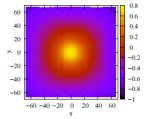EPJ B Highlight - Surfing over simulated ripples in graphene
- Details
- Published on 17 September 2015

Scientists from India elucidate the theory governing the characteristics of curved or rippled graphene using a simulation model based on an optical lattice
The single-carbon-atom-thick material, graphene, featuring ripples is not easy to understand. Instead of creating such ripples physically, physicists investigating this kind of unusually shaped material rely on a quantum simulator. It is made up of an artificial lattice of light - called ultra-cold optical lattice - akin to eggs held in the cavities of an egg tray. This approach allowed a team of theoretical physicists from India to shed some light - literally and figuratively - on the properties of rippled graphene. These findings have just been published in EPJ B by Tridev Mishra and colleagues from the Birla Institute of Technology and Science, in Pilani, India. Ultimately, this work could find applications in novel graphene-based sensors.
Optical lattices are perfect simulators. They are like mini-laboratories suitable for studying the response of a material after it has been subjected to controllable parameters inducing a deformation. What makes this particular study novel is that the team has managed to control the creation of a curved space or ripples in graphene by relying on an optical lattice simulator. The authors have thus developed a theory describing how a sequence of pulses, whose amplitude can be modulated, changes an optical lattice - specifically, the background geometry of its constituent particles. Previous modelling attempts only described static curved graphene.
Mishra and colleagues have established equations of the energy for particles caught in an optical lattice. This, in turn, simulates the energy of the electrons in a graphene sheet with a curvature. They then use a map to translate the physical characteristics of the approximation used in the curved space picture of graphene to the more realistic optical lattice picture. They thus obtain an understanding of the dynamics of the evolution from the ‘egg in a tray’ structure of the optical lattice in terms of the properties of ‘an omelette style’ continuum of energy found in graphene.
T. Mishra, T. G. Sarkar, and J. N. Bandyopadhyay (2015), Floquet analysis of pulsed Dirac systems: A way to simulate rippled graphene, Eur. Phys. J. B 88:231, DOI: 10.1140/epjb/e2015-60356-2





